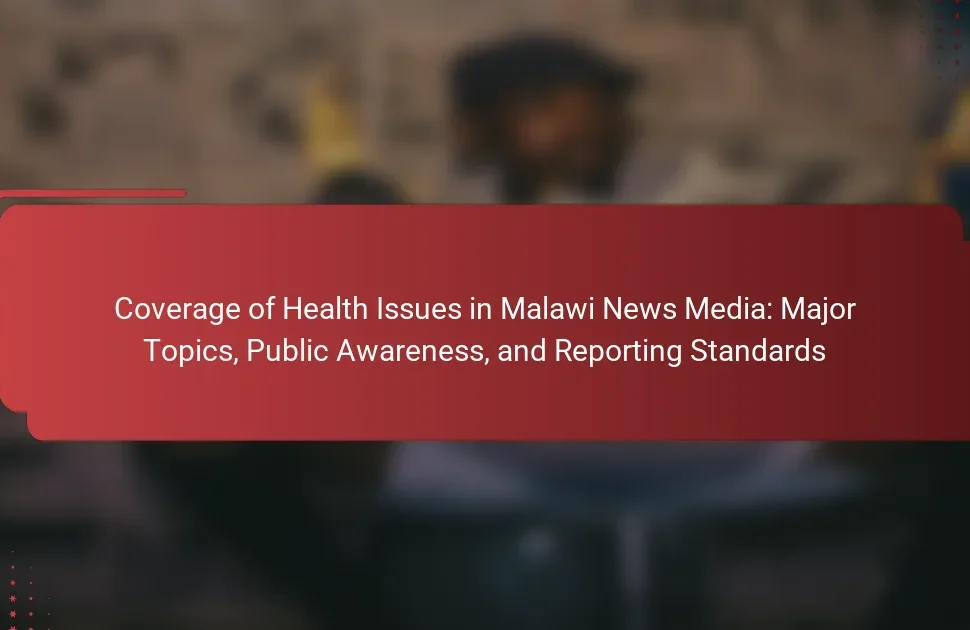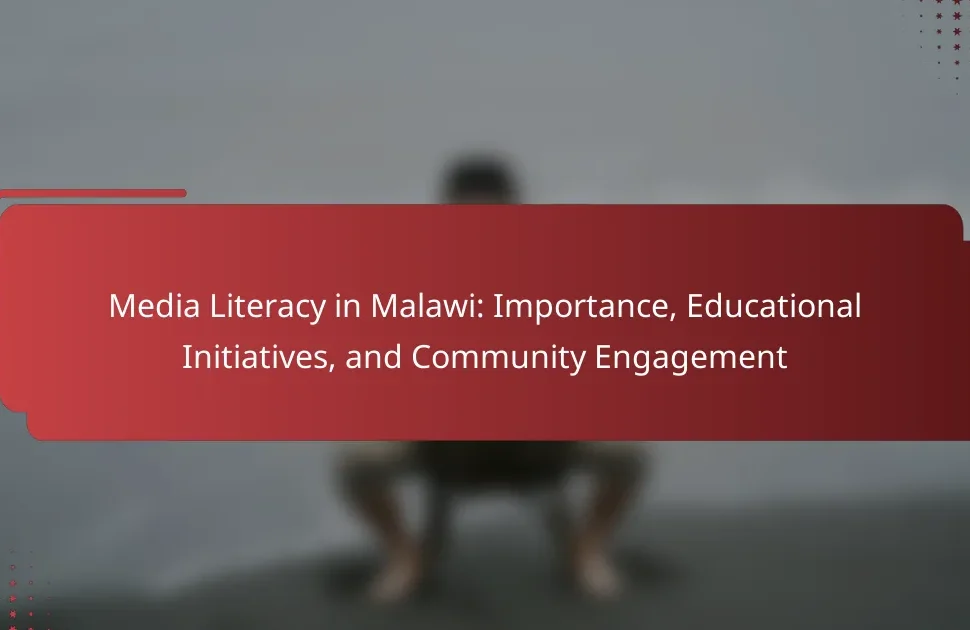Broadcast journalism in Malawi is currently navigating a complex landscape marked by both challenges and opportunities. The sector includes state-owned and private broadcasters, with ongoing concerns regarding government influence on editorial independence. As digital technology reshapes news production and consumption, there is a notable shift towards online platforms, with over 70% of Malawians accessing news via mobile devices. Key trends influencing the future of broadcast journalism include increased digital integration, enhanced audience engagement through social media, and a focus on local content that resonates with community issues. To thrive in this evolving environment, broadcast journalists must adopt innovative storytelling techniques, improve multimedia production skills, and foster community engagement.

What is the current state of broadcast journalism in Malawi?
Broadcast journalism in Malawi is currently facing significant challenges and opportunities. The media landscape is characterized by a mix of state-owned and private broadcasters. Government influence remains a concern, affecting editorial independence. However, there is a growing demand for diverse content and improved quality. The advent of digital technology is reshaping how news is produced and consumed. Many Malawians are turning to online platforms for news. This shift presents both a challenge and an opportunity for traditional broadcasters. Recent reports indicate a need for investment in training and infrastructure. Overall, broadcast journalism in Malawi is evolving amidst these dynamics.
How has broadcast journalism evolved in Malawi over the years?
Broadcast journalism in Malawi has evolved significantly since its inception. Initially, it was characterized by limited access and government control. The first radio station, Malawi Broadcasting Corporation, was established in 1965. It operated under strict regulations and focused on government propaganda. In the 1990s, Malawi experienced political changes that led to the liberalization of the media. This resulted in the emergence of private radio and television stations. The introduction of satellite technology further expanded broadcasting capabilities. Today, digital platforms and social media play a crucial role in news dissemination. This shift allows for greater audience engagement and diverse content. The evolution reflects a growing demand for independent journalism and varied viewpoints.
What historical events have shaped the broadcast journalism landscape in Malawi?
The broadcast journalism landscape in Malawi has been shaped by several key historical events. The introduction of independent broadcasting in the 1990s marked a significant shift. This change followed years of state-controlled media under a one-party system. The transition to multiparty democracy in 1994 allowed for greater media freedom.
The establishment of private radio stations, such as Radio Maria and Capital Radio, diversified the media landscape. The 2004 Media and Communications Policy aimed to promote freedom of expression and media independence. Additionally, the rise of digital technology in the 2000s transformed news dissemination.
The 2019 elections highlighted the role of social media in broadcasting journalism. These events collectively influenced the development and evolution of broadcast journalism in Malawi.
What are the key milestones in the development of broadcast journalism in Malawi?
The key milestones in the development of broadcast journalism in Malawi include the establishment of the Malawi Broadcasting Corporation (MBC) in 1965. This marked the beginning of formal broadcasting in the country. In 1994, Malawi transitioned to a multiparty democracy, leading to the liberalization of the media landscape. This resulted in the launch of private radio stations and television channels. The introduction of digital broadcasting in the early 2000s further transformed the sector. In 2016, the government implemented the Digital Migration Policy, enhancing broadcast quality and accessibility. These milestones have significantly shaped the evolution of broadcast journalism in Malawi, fostering a more diverse media environment.
What are the major challenges facing broadcast journalism in Malawi?
The major challenges facing broadcast journalism in Malawi include limited funding, government interference, and lack of training. Limited funding restricts resources for quality programming and equipment. Government interference often leads to censorship and stifles journalistic freedom. Lack of training results in a workforce that struggles with modern reporting techniques. According to a 2021 report by the Media Institute of Southern Africa, these issues significantly hinder the growth and credibility of broadcast journalism in the country.
How do political influences affect broadcast journalism in Malawi?
Political influences significantly affect broadcast journalism in Malawi by shaping content and editorial decisions. Journalists often face pressure from government officials and political parties. This pressure can lead to self-censorship among media professionals. According to a 2021 report by the Media Institute of Southern Africa, many journalists reported fear of repercussions for critical reporting. The government has been known to restrict access to information, impacting the media’s ability to report freely. Additionally, ownership of media outlets often aligns with political interests. This alignment can skew news coverage in favor of certain political narratives. As a result, the public may receive biased information that affects their understanding of political issues.
What financial constraints impact the sustainability of broadcast journalism in Malawi?
Broadcast journalism in Malawi faces significant financial constraints that hinder its sustainability. Limited advertising revenue is a primary issue, as many businesses lack the budget for media promotions. Additionally, low audience reach reduces potential ad income. High operational costs further strain resources, making it difficult for stations to maintain quality programming. Funding from government or international sources is often inconsistent. Many journalists are underpaid, leading to high turnover rates. These financial challenges ultimately threaten the viability of broadcast journalism in the country.

What emerging trends are shaping the future of broadcast journalism in Malawi?
Emerging trends shaping the future of broadcast journalism in Malawi include increased digital integration, audience engagement through social media, and a focus on local content. Digital platforms are becoming essential for news distribution, allowing for real-time updates and broader reach. Social media engagement is fostering direct communication between journalists and audiences, enhancing feedback and interaction. Additionally, there is a growing emphasis on producing content that reflects local issues and cultures, catering to the audience’s preferences. Research shows that over 70% of Malawians access news via mobile devices, highlighting the shift towards digital consumption. These trends indicate a transformation in how broadcast journalism operates, adapting to technological advancements and audience expectations.
How is digital transformation impacting broadcast journalism in Malawi?
Digital transformation is significantly impacting broadcast journalism in Malawi by enhancing accessibility and engagement. Journalists now utilize digital platforms for news dissemination. This shift allows for real-time reporting and broader audience reach. Social media plays a crucial role in audience interaction. According to a 2022 report by the Malawi Communications Regulatory Authority, digital news consumption has increased by 40% in the past two years. This trend reflects changing audience preferences towards online content. Additionally, digital tools enable more diverse storytelling methods, including video and multimedia. Overall, digital transformation is reshaping the landscape of broadcast journalism in Malawi, fostering innovation and audience connection.
What role does social media play in the dissemination of news in Malawi?
Social media plays a crucial role in the dissemination of news in Malawi. It serves as a primary platform for sharing real-time information. Many Malawians rely on social media for breaking news updates. Platforms like Facebook and Twitter are widely used for news distribution. This trend has increased access to diverse viewpoints and information. Research indicates that over 40% of Malawians use social media for news. This shift affects traditional media consumption patterns. Social media also facilitates citizen journalism, allowing individuals to report news events. This democratizes information flow and enhances public engagement.
How are traditional media adapting to new technologies in Malawi?
Traditional media in Malawi are increasingly adopting new technologies to enhance their operations. They are integrating digital platforms to reach broader audiences. Radio stations are using social media for real-time engagement with listeners. Television networks are developing mobile applications for on-demand content access. Many print media are transitioning to online formats to cater to digital readers. Additionally, traditional media organizations are investing in training for staff on new media skills. This shift reflects a response to changing audience preferences for immediate and accessible news. The adaptation is essential for maintaining relevance in a rapidly evolving media landscape.
What audience preferences are emerging in the context of broadcast journalism in Malawi?
Emerging audience preferences in broadcast journalism in Malawi include a demand for localized content. Viewers increasingly prefer news that reflects their community’s issues and culture. There is a growing interest in interactive programming, allowing audience participation. Social media integration is also becoming important, as audiences seek news updates through these platforms. Additionally, younger audiences favor shorter, visually engaging news segments. Research indicates that 70% of Malawians access news primarily via mobile devices, highlighting a shift towards digital consumption. This trend underscores the need for broadcasters to adapt to changing viewer habits.
How do Malawian audiences consume news differently today compared to the past?
Malawian audiences consume news today primarily through digital platforms, a shift from traditional print and broadcast media. The rise of mobile phone usage has enabled access to news via social media and news apps. In the past, audiences relied heavily on newspapers and radio for information. Research indicates that over 60% of Malawians now access news online, compared to only 25% a decade ago. This change reflects a broader trend towards immediacy and interactivity in news consumption. Additionally, younger audiences prefer video content on platforms like YouTube, further diversifying how news is consumed. This evolution in consumption patterns highlights the impact of technology on information dissemination in Malawi.
What demographic factors influence audience preferences for broadcast journalism in Malawi?
Demographic factors influencing audience preferences for broadcast journalism in Malawi include age, education level, and urban versus rural residency. Younger audiences tend to prefer digital platforms for news consumption. Older generations often favor traditional television and radio broadcasts. Higher education levels correlate with a preference for in-depth reporting and investigative journalism. Conversely, audiences with lower education levels may prefer simpler news formats. Urban residents typically have access to a wider variety of news sources compared to rural audiences, who may rely more on local broadcasts. These trends reflect the diverse media landscape in Malawi and the varying needs of different demographic groups.

How can broadcast journalists in Malawi adapt to future challenges and opportunities?
Broadcast journalists in Malawi can adapt to future challenges and opportunities by embracing digital platforms and innovative storytelling techniques. The rise of social media has changed audience consumption habits. Journalists must develop skills in multimedia production to engage viewers effectively. Training in data journalism can enhance reporting accuracy and relevance. Collaborating with tech companies can provide access to advanced tools and resources. Understanding audience preferences through analytics can guide content creation. Additionally, fostering community engagement will strengthen local relevance. Adapting to these trends is crucial for sustaining impact in the evolving media landscape.
What skills will be essential for future broadcast journalists in Malawi?
Future broadcast journalists in Malawi will need strong multimedia skills. They must be proficient in video editing and audio production. Knowledge of social media platforms is essential for audience engagement. Journalists should also have strong storytelling abilities to captivate viewers. Understanding data journalism will help them analyze and present information effectively. Adaptability to new technologies is crucial in a rapidly changing media landscape. Additionally, ethical reporting skills are necessary to maintain credibility. Collaborative skills will enhance teamwork in newsrooms.
How can journalists improve their digital literacy in a changing media landscape?
Journalists can improve their digital literacy by engaging in continuous education and training. They should participate in workshops focused on digital tools and platforms. Online courses can also enhance their skills in data journalism and multimedia storytelling. Networking with tech-savvy professionals can provide insights into emerging technologies. Utilizing social media analytics can help journalists understand audience engagement better. Adopting new software for content creation can streamline their workflow. Staying updated with industry trends is crucial for adapting to changes. Research shows that journalists with higher digital literacy produce more engaging and relevant content.
What ethical considerations should journalists prioritize in the future?
Journalists should prioritize accuracy, transparency, and accountability in the future. Accuracy ensures that information is correct and reliable. Transparency involves being open about sources and methods used in reporting. Accountability means taking responsibility for the impact of their work on society. These ethical considerations are vital in maintaining public trust. Trust is essential for effective journalism. A study by the Reuters Institute for the Study of Journalism highlights that trust in media affects audience engagement. Upholding these ethics can help journalists navigate challenges posed by misinformation and digital media.
What best practices can enhance the effectiveness of broadcast journalism in Malawi?
Implementing community engagement initiatives can enhance the effectiveness of broadcast journalism in Malawi. This practice fosters trust and encourages audience participation. Training journalists in ethical reporting and fact-checking improves content credibility. Additionally, utilizing digital platforms expands reach and accessibility. Collaborating with local organizations can provide valuable insights into community needs. Investing in technology upgrades ensures high-quality production standards. Providing diverse programming caters to varied audience interests. Regular audience feedback mechanisms help tailor content to viewer preferences.
How can collaboration among media organizations improve broadcast journalism quality?
Collaboration among media organizations can significantly improve broadcast journalism quality. By sharing resources, organizations can enhance their investigative capabilities. Joint training programs can elevate the skill sets of journalists. Collaborative news coverage can provide diverse perspectives on issues. This leads to more comprehensive reporting. A study by the Pew Research Center found that collaboration can result in increased audience trust. Trust is crucial for audience engagement and retention. Sharing best practices can also foster innovation in storytelling techniques. Overall, collaboration enhances the credibility and depth of broadcast journalism.
What strategies can journalists use to engage and retain their audience effectively?
Journalists can engage and retain their audience effectively by utilizing interactive content, storytelling techniques, and social media platforms. Interactive content, such as polls and quizzes, encourages audience participation. Storytelling techniques create emotional connections and make news more relatable. Social media platforms allow for real-time engagement and feedback. According to a 2021 Pew Research study, 53% of news consumers prefer news that includes audience interaction. This highlights the importance of engagement strategies in retaining audience interest.
The main entity of this article is broadcast journalism in Malawi. The article provides an overview of the current state, historical evolution, and key challenges facing broadcast journalism in Malawi, highlighting the impact of digital transformation and social media on news consumption. It discusses emerging trends, audience preferences, and essential skills for future journalists, emphasizing the importance of ethical considerations and collaboration among media organizations. The content addresses the financial constraints and political influences affecting the sustainability and independence of broadcast journalism in the country, outlining strategies for adaptation and engagement in a rapidly changing media landscape.




